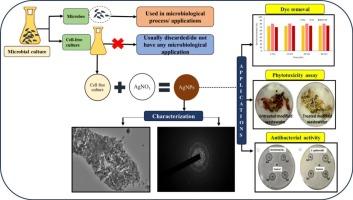Valorization of the halo-alkaliphilic bacterial culture supernatant of Nesterenkonia lacusekhoensis EMLA3 for sustainable silver nanoparticles synthesis: Insights into catalytic dye removal, antibacterial activity, and phytotoxicity of treated wastewater
IF 4.6
3区 材料科学
Q2 MATERIALS SCIENCE, MULTIDISCIPLINARY
引用次数: 0
Abstract
Introduction of dye-laden wastewater into aquatic ecosystems and the increasing challenge of antibiotic resistance pose environmental and human health risks. Addressing these, this study aimed to evaluate the capability of green-synthesised silver nanoparticles (AgNPs) as a sustainable strategy. Herein, leftover supernatant obtained post-separation of an extremophilic bacterial culture was used for AgNPs synthesis. AgNPs efficacy in decolorizing Methyl Orange (MO) and Congo Red (CR) was evaluated under different process parameters. The synthesized nanoparticles catalysed > 95 % dye decolorization efficiency at pH 11 and 10 % salt concentration when applied to 500 ppm of both dyes, individually. AgNPs demonstrated > 70 % dye decolorization when tested in modified textile wastewater having a mixture of 50 ppm MO and 50 ppm CR dyes. AgNPs also exhibited antimicrobial activity against both Gram-positive and Gram-negative bacteria. Hence, this study highlights the potential of AgNPs in wastewater treatment and as an effective antibacterial agent.

Nesterenkonia lacusekhoensis EMLA3的嗜碱性细菌培养上清对可持续纳米银合成的价值:对催化染料去除,抗菌活性和处理废水的植物毒性的见解
含染料废水进入水生生态系统以及抗生素耐药性日益严峻的挑战构成了环境和人类健康风险。针对这些问题,本研究旨在评估绿色合成纳米银(AgNPs)作为一种可持续战略的能力。在这里,嗜极细菌培养分离后获得的剩余上清用于AgNPs合成。考察了不同工艺参数下AgNPs对甲基橙(MO)和刚果红(CR)的脱色效果。合成的纳米颗粒在pH为11和盐浓度为10%时,分别应用于500ppm的两种染料,催化染料脱色效率为95%。在含有50 ppm MO和50 ppm CR染料的改性纺织废水中进行测试时,AgNPs的染料脱色率为70%。AgNPs对革兰氏阳性菌和革兰氏阴性菌均表现出抗菌活性。因此,本研究强调了AgNPs在废水处理和作为有效抗菌剂方面的潜力。
本文章由计算机程序翻译,如有差异,请以英文原文为准。
求助全文
约1分钟内获得全文
求助全文
来源期刊

Materials Science and Engineering: B
工程技术-材料科学:综合
CiteScore
5.60
自引率
2.80%
发文量
481
审稿时长
3.5 months
期刊介绍:
The journal provides an international medium for the publication of theoretical and experimental studies and reviews related to the electronic, electrochemical, ionic, magnetic, optical, and biosensing properties of solid state materials in bulk, thin film and particulate forms. Papers dealing with synthesis, processing, characterization, structure, physical properties and computational aspects of nano-crystalline, crystalline, amorphous and glassy forms of ceramics, semiconductors, layered insertion compounds, low-dimensional compounds and systems, fast-ion conductors, polymers and dielectrics are viewed as suitable for publication. Articles focused on nano-structured aspects of these advanced solid-state materials will also be considered suitable.
 求助内容:
求助内容: 应助结果提醒方式:
应助结果提醒方式:


